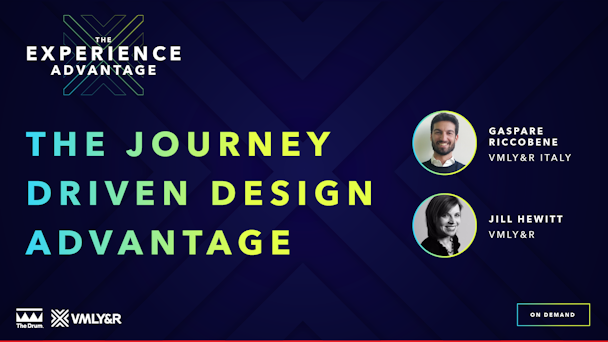Creating connected brands through journey-driven design
Behind every atom of design, piece of technology and data point is a human action or insight. When we obsess over the human, and not just a slice of data, we can focus on serving real people – not algorithms. This is the journey-driven design advantage.

Watch ‘The journey-driven design advantage’ on demand
“Journeys are a powerful tool – they illuminate moments that matter and opportunities to improve lives,” said Jill Hewitt, group director of experience design at VMLY&R, at 'The Experience Advantage festival.' “Journeys inform both brand experiences (BX) and customer experiences (CX) and are even more powerful when the two come together to create a connected brand.”
A brand makes a promise to the world and it must live up to that promise at every step of the customer journey. When the customer’s experience doesn’t live up to expectations, trust in the brand is lost. “In other words, a poor experience will break a great promise,” Hewitt said. “And on the other hand, a poor promise will starve a great experience.” Journeys help to define how BX and CX work together.
Hewitt highlighted three elements that make journeys powerful: focusing on real people to find opportunities to improve their lives; using data to provide context which strengthens experiences; and defining and embracing their modern ecosystem.
Experiences defined by the human and their journey
A journey is created by tapping into real people and understanding them a human beings.
“We use a variety of different research methodologies to help us understand people’s needs, their pain points, the things they are doing and what they are feeling,” said Hewitt. “As we pull out all of these insights, we use ‘jobs theory’. We’re looking at functional, social and emotional jobs to be done, which are just problems that customers are trying to make progress against.”
Most journeys are divided up into stages, which are logical units of customer time and activity. Once the human functional, social and emotional jobs to be done have been mapped to each stage of the journey, marketers can step back and look for opportunity areas – including unmet needs or moments of loss. These become the moments to ideate against and develop new experiences that will help real people in their lives.
Using data to take your customer from anonymous to known
With a solid understanding of the people you want to serve in place, the next step is to leverage data and context to inform designs that are meaningful. Data allows brands to pinpoint where a customer is along the journey – building context for personalized and meaningful experiences.
“The more we know about a person, the more personal the experience becomes, which in turn provides increased value to the customer,” said Hewitt.
Embracing the modern ecosystem
After identifying the needs of real people and finding ways to use data to make the experiences more meaningful, the next step is to leverage a modern ecosystem of touchpoints. By taking into account all interactions that customers may have with your brand, it is possible to bring experiences to life across multiple channels at each stage of the journey – making them even more powerful.
“We not only look at all the touchpoints, but the full technology stack that supports those touchpoints,” said Hewitt. “The experiences that we imagine must be possible by the supporting technology platform. The two need to work together. As we develop new experiences, we map them back to our journey – illustrating where human needs are met with brand experinces.”
Lavazza’s journey-driven design advantage
One case study of a successful journey-driven design approach is Lavazza, the Italian coffee brand. Gaspare Riccobene, head of customer experience and innovation at VMLY&R Italy, highlighted how the three elements of journey-driven design were brought to life for Lavazza.
“From data to data, we focused on real people to find opportunities to improve their lives,” said Riccobene. “First, we had data and technology as a competitive advantage, and second, we developed a seamless digital ecosystem that generated tangible business results. We also invested in data profiling while keeping privacy as a top priority for customers. Personalisation is the key because personalised marketing drives growth – the higher the investment, the better returns, and personalisation leads to long term customer value.”
Content created with:

VML
VML is a leading creative company that combines brand experience, customer experience, and commerce, creating connected brands to drive growth. VML is celebrated...
Find out more